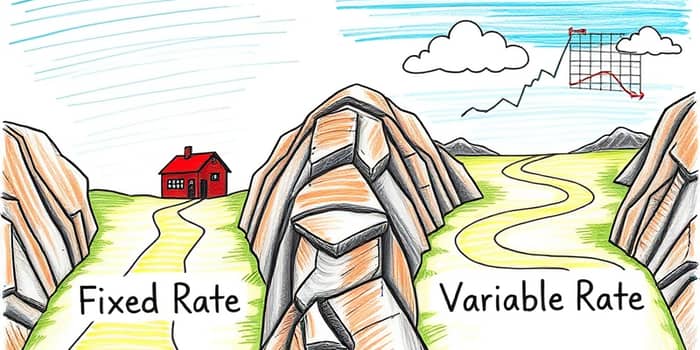
Navigating mortgage choices can feel like solving a labyrinth. From rate types to economic signals, many factors influence which product best aligns with your financial journey. This guide breaks down fixed and variable options, offers up-to-date rates, explores trends, and provides actionable examples. Whether you desire certainty or can embrace change, you’ll gain the insights needed to emerge from the mortgage maze with confidence.
A fixed-rate mortgage locks your interest at a set percentage throughout the loan term, commonly 15 or 30 years. This model ensures predictable monthly payments and budgeting by shielding borrowers from market volatility. Fixed-rate products appeal to homeowners seeking long-term stability, as payment amounts do not fluctuate even when economic conditions shift.
On the other hand, a variable-rate mortgage starts lower with an introductory fixed period—often 3, 5, 7, or 10 years. After this phase, the rate resets periodically based on a reference index such as SOFR or the prime rate. While initial rates are typically less than fixed counterparts, future payments may climb if underlying benchmarks rise.
Mortgage rates have climbed in recent years, reflecting broader inflation and central bank policy shifts. Below are average APRs for borrowers with strong credit scores:
Fees, origination points, and lender-specific terms can add up to 0.5% more to your effective rate. Historically, rates dipped near 2.65% in 2021 and soared above 7% in early 2025, marking a swift reversal as economies reopened post-pandemic.
Regional variations can shift these averages by ±0.25%. Borrowers with credit scores above 760 often secure the lowest advertised rates, while those with scores between 620 and 700 may pay a premium. Lenders also factor in loan-to-value ratios; putting down more than 20% can eliminate private mortgage insurance and reduce your rate.
Choosing between fixed and variable involves balancing certainty against potential savings. Consider the table below for a concise overview:
For borrowers worried about rising budgets, fixed rates offer unrivaled peace of mind. Those with shorter horizons or faith in declining rates may prefer an ARM for potential savings if rates drop, albeit with added uncertainty after the teaser period ends.
Additionally, some fixed-rate products allow flexible prepayment without penalties, enabling principal reduction over time. Conversely, ARMs sometimes include prepayment penalties, which can offset the benefit of initial savings if you refinance early.
Fixed-rate loans align closely with the yields on 10-year U.S. Treasuries or Canadian government equivalents. When investors demand higher yields to offset inflation fears, mortgage lenders pass those increases on through long-term bond market movements. Conversely, yields drop during risk-off scenarios, nudging rates lower.
Variable-rate products hinge on short-term benchmarks like the prime rate or SOFR, which track central bank policy. A Fed rate hike intended to tame inflation immediately ripples through to mortgage payments tied to the prime. Conversely, easing cycles may stimulate borrowing with reduced costs.
Beyond bonds and benchmark rates, macroeconomic indicators like inflation, GDP growth, and unemployment figures indirectly steer mortgage pricing. Lenders build in risk premiums based on market volatility; volatile credit markets can widen the margin between index rates and the final APR offered.
Hybrid mortgages blend elements of fixed and variable structures to offer a compromise. A common hybrid might lock in a rate for five years, then switch to an ARM for the remainder of the term. This design grants stability initially, followed by exposure to market movements.
Understanding cap structures—annual and lifetime limits on rate increases—is critical to evaluating hybrid products. These guardrails prevent runaway costs if rates spike. Keep in mind that hybrid structures can become complex when combining multiple adjustment periods or incorporating interest rate floors. Always review the adjustment frequency, margin, and cap hierarchy to fully grasp potential future payment scenarios.
Your personal profile shapes the ideal mortgage choice. Ask yourself key questions: How long will I stay in this home? Can I tolerate higher payments if rates rise? What is my credit score and down payment size? These inputs determine lender offerings and your risk comfort.
Factor in prepayment privileges, potential refinancing fees, and penalty structures before finalizing your choice. Life events—such as job instability, growing families, or imminent relocations—should influence whether you lock in a rate or gamble on market movements. A variable rate could lead to higher costs if inflation remains entrenched, but could reward you with savings in the event of a rate-cutting cycle.
Examining real numbers helps demystify abstract percentages. For a $400,000 mortgage with $100,000 down over 30 years:
• A 5-year ARM at 5.53% yields payments of $2,279 per month for the initial five years. Afterward, adjustments occur annually based on the chosen index plus lender margin, with rate caps limiting year-to-year and lifetime increases.
• A fixed rate at 7.26% costs $2,731 monthly for the loan’s duration, barring a refinance. Despite higher payments, this route offers predictable payment security and shields you from unexpected rate spikes.
Reviewing an amortization schedule illustrates how each payment shifts from interest-heavy to principal-heavy over time. Early ARM payments allocate less principal reduction, whereas fixed-rate loans steadily build equity each month. Factor mortgage insurance and property taxes into your overall housing budget.
Mortgage rates reached historic lows in early 2021 due to aggressive central bank stimulus during the COVID-19 crisis. However, robust post-pandemic growth and inflationary pressures prompted successive rate hikes, driving averages above 7% in 2025. Economists anticipate rates will hover between 6% and 7% in the near term, barring geopolitical shocks or fresh crises.
Looking back to the 2008 financial crisis, mortgage rates spiked briefly as credit markets seized up, before tumbling to historic lows amid quantitative easing. The 2020 pandemic triggered a similar rapid descent, but the recovery from COVID-19 led to an aggressive tightening cycle. These cycles underscore the importance of aligning mortgage terms with broader economic cycles.
Borrowers should plan for sustained rate levels or minor fluctuations around current benchmarks. Maintaining flexibility through refinancing options and monitoring economic indicators can help adapt strategies over the life of your loan.
Whether you favor the unwavering predictability of fixed rates, the initial affordability of ARMs, or the hybrid strategy’s nuanced trade-offs, the optimal mortgage reflects both current market realities and your personal roadmap. Remaining informed about rate trends, understanding fine print details like adjustment caps and prepayment penalties, and regularly reviewing refinancing opportunities will empower you to make adjustments as markets shift. With thorough preparation and expert guidance, you can navigate the mortgage maze and secure a loan structure that aligns with your goals today and adapts to your needs tomorrow.
References













